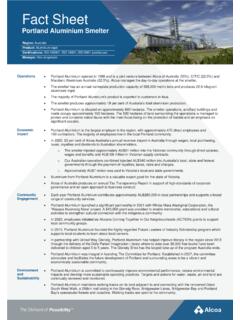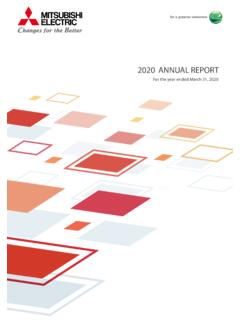Transcription of Rate the Raters 2020 Report - The SustainAbility Institute ...
1 Introduction | Rate the Raters 2020 | 1 Rate the Raters 2020:Investor Survey and Interview ResultsMarch 2020 Introduction | Rate the Raters 2020 | 2 About this ReportSustainAbility, an ERM Group company, is a think tank and advisory firm that works to inspire and enable business to lead the way to a sustainable economy. Our agenda-shaping research challenges individuals, companies and industries to transform the ways they think and do business, and explains how to make lasting change. All SustainAbility research reports are publicly available at the Raters Research Series In 2010, SustainAbility undertook its first Rate the Raters project to better understand the environmental, social, and governance (ESG) ratings landscape and provide perspectives to help companies, investors and other stakeholders make sense of and derive more value from ESG ratings.
2 In 2017, SustainAbility revisited this topic in order to provide an updated view of stakeholder perspectives and shed light on how ESG ratings were being used, as well as to identify challenges and provide recommendations. Rate the Raters 2018: Ratings Revisited outlined themes that emerged from several roundtables and interviews with investors, companies and ratings research firms and explored why the topic merited new research. These roundtables informed the work conducted in 2019-2020 that culminates with this the Raters 2019 2020 The first Report , Rate the Raters 2019: Expert Survey Results, focused on key insights from a survey of over 300 SustainAbility professionals in corporate, NGO, government, academic and other sectors.
3 Phase two, this Report , was designed to highlight the perspectives of investors. It shares insights from 17 in-depth interviews with investors, supplemented by a survey of 25 investors, highlighting their views on current ESG ratings and how they use these ratings to evaluate ESG topics. The Report also includes specific recommendations for companies on how to approach the ESG ratings landscape in order to meet investor needs. We hope that this research will spur further dialogue between investors, corporations and ESG research/rating firms to improve the ESG ecosystem for all stakeholders.
4 We welcome your feedback and suggestions. Rate the Raters 2020 | 2 Introduction | Rate the Raters 2020 | 3 AcknowledgementsWe express sincere thanks to our sponsors for their generous support; our interviewees and survey respondents; GlobeScan for distributing the survey; and, all of our SustainAbility , BrownFlynn, and other ERM Group colleagues and peers who generously contributed their time and insights to this Christina Wong Erika PetroyContributorsAiste BrackleyMark LeeOur Sponsors Rate the Raters 2020 | 3 Introduction | Rate the Raters 2020 | 4 ContentsIntroductionObjectives and MethodologyKey FindingsInvestor InsightsTop Sources of ESG InformationESG Ratings Use FrequencyNumber of ESG Ratings UsedESG Ratings SelectionHow Investors Use ESG RatingsInvestor Critiques of ESG RatingsInvestor
5 Perceptions of Specific ESG RatingsInvestor Future Views and ExpectationsFinal Recommendations for Companies Conclusion Appendix 050812161718191922283341464850 Rate the Raters 2020 | 4 Introduction | Rate the Raters 2020 | 5 Introduction Rate the Raters 2020 | 5 Introduction | Rate the Raters 2020 | 6A decade of ratings, growth and evolution Since our original Rate the Raters research series launched in 2010 and concluded in 2013, the size, influence and complexity of the ESG ecosystem have all increased significantly.
6 The number of ESG standards and frameworks, data providers, ratings and rankings has expanded, with 600+ ESG ratings and rankings existing globally as of 2018 and continuing to grow since. As this system has developed, it has influenced how companies Report on and disclose ESG data and performance, shaped the creation of ESG-related investment products, and framed the public perception of companies. During this period, complexity has increased, as more traditional investment data providers, credit rating agencies and others have entered the ratings marketplace, driving merger and acquisition activity.
7 Recent examples of this dynamism include Moody s acquisition of a majority stake in Vigeo Eiris as well as S&P Global s purchase of the ESG business of RobecoSAM , including its well-known Corporate SustainAbility Assessment (CSA), which underpins the Dow jones SustainAbility of ratings field dynamism The rapid expansion of the ESG ecosystem has been driven in part by increased corporate reporting, which has generated reams of new and better ESG data. From 2011 to 2018, the proportion of S&P 500 companies reporting on their SustainAbility efforts, corporate social responsibility activities, and ESG performance increased from just under 20% to 86%.
8 At the same time, investors have been exploring pathways for ESG integration, reactively looking to better understand corporate ESG performance in order to better respond to client pressure, and proactively seeking means to apply ESG in ways that might improve investment decisions. Indicative of this growth, the more than 2,300 signatories to the UN Principles for Responsible Investment (PRI), with over $80 trillion in collective assets under management (AUM), have committed to incorporating ESG issues into investment analysis and decision-making process.
9 Meanwhile, increasing stakeholder pressure was reflected in a 2019 Harvard Business Review (HBR) article noting asset owners are facing growing demand from clients to ensure that their investments make a difference in the world. The HBR piece quoted Michael Baldinger, head of Sustainable and Impact Investment at UBS Asset Management, who said The demand for ESG investment options is so high that many asset management firms are rushing to pull together new offerings. Sustainable and impact investment at UBS Asset Management has more than tripled since December 2016, with $17 billion in AUM.
10 Moody s Acquires Majority Stake in Vigeo Eiris, a Global Leader in ESG Assessments . Businesswire. Web. April 2019. S&P Global to Acquire the ESG Ratings Business from RobecoSAM . S&P Global. Web. November 2019. 86% of S&P 500 index Companies Publish SustainAbility / Responsibility Reports in 2018 . Sustinability Reports. Web. May 2019. About PRI . Principles for Responsible Investment. Web. 2019. Robert G. Eccles and Svetlana Klimenko. The Investor Revolution . Harvard Business Review.

